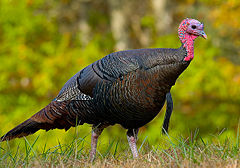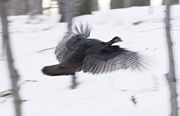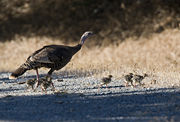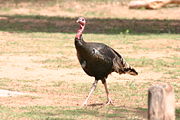Wild Turkey
| Wild Turkey | ||||||||||||||
|---|---|---|---|---|---|---|---|---|---|---|---|---|---|---|
 Male
|
||||||||||||||
| Conservation status | ||||||||||||||
| Scientific classification | ||||||||||||||
|
||||||||||||||
| Binomial name | ||||||||||||||
| Meleagris gallopavo Linnaeus, 1758 |
The Wild Turkey (Meleagris gallopavo) is native to North America and is the heaviest member of the Galliformes. It is one of two species of turkey, the other being the Ocellated Turkey, found in Central America.
Contents |
Biology
Adult male Wild Turkeys have a small, featherless, reddish head that can change to blue in minutes; a red throat in males; long reddish-orange to greyish-blue legs; and a dark-brown to black body. The head has fleshy growths called caruncles; in excited turkeys, a fleshy flap on the bill expands, becoming engorged with blood. Males have red wattles on the throat and neck. Each foot has four toes, and males have rear spurs on their lower legs.
Turkeys have a long, dark, fan-shaped tail and glossy bronze wings. As with many other species of the Galliformes, turkeys exhibit strong sexual dimorphism. The male is substantially larger than the female, and his feathers have areas of red, purple, green, copper, bronze, and gold iridescence. Female feathers are duller overall, in shades of brown and gray. Parasites can dull coloration of both sexes; in males, coloration may serve as a signal of health.[2] The primary wing feathers have white bars. turkeys have 20,000 to 30,000 feathers. Tail feathers have the same length in adults, different lengths in juveniles. Males typically have a "beard" consisting of modified feathers that stick out from the breast. Beards average 9 inches (230 mm) in length. In some populations, 10 to 20 percent of females have a beard, usually shorter and thinner than that of the male. The adult male normally weighs from 5 to 11 kg (11-24 lbs) and measures 100-125 cm (39-49 in). The adult female is typically much smaller at 3 to 5.4 kg (6.6-12 lbs) and are 76 to 95 cm (30-37 in) long. The wingspan ranges from 1.25 to 1.44 m (49-57 in). The record-sized adult male wild turkey, according to the National Wildlife Turkey Federation, was 38 lb (17.2 kg).
Flight and calls

Wild Turkeys are surprisingly agile fliers and very cunning, unlike their domestic counterparts. Turkeys are very cautious birds and will fly or run at the first sign of danger. In flight they can reach a speed of 50 miles per hour (80 km/h). They usually fly close to the ground for no more than a quarter mile (400 m). Turkeys have many vocalizations: "gobbles," "clucks," "putts," "purrs," "yelps," "cutts," "whines," "cackles," and "kee-kees." In early spring, male turkeys, also called gobblers or toms, gobble to announce their presence to females and competing males. The gobble can carry for up to a mile. Males also emit a low-pitched drumming sound. Hens "yelp" to let gobblers know their location. Gobblers often yelp in the manner of females, and hens can gobble, though they rarely do so. Immature males, called jakes, yelp often. Wild Turkey hunting in the United States and Mexico is a multi-million dollar industry. Hunting in the spring consists of calling a tom "male turkey" using hen calls because turkeys mate in the spring depending upon the area and subspecies. Fall turkey hunting consists of breaking up a flock and calling them back together using "clucks" or "kee kee" vocalizations that the Wild Turkey makes. The most common weapon used for hunting turkeys is a semiautomatic or pump 16-12 gauge shotgun but some use a muzzeloader or even a compound bow for the ultimate challenge. Turkeys have amazing eyesight and are very stealthy so they are a hard animal to hunt especially in heavily hunted areas as the birds "wise up" extremely fast.
Foraging
Wild Turkeys are omnivorous, foraging on the ground or climbing shrubs and small trees to feed. They prefer eating hard mast such as acorns,nuts, and various trees, including hazel, chestnut, hickory, and pinyon pine as well as various seeds, berries such as juniper and bearberry, roots and insects. Turkeys are also known to occasionally consume small vertebrates like snakes, frogs or salamanders. Poults have been observed eating insects, berries, and seeds. Wild turkeys often feed in cow pastures. They sometimes visit backyard bird feeders to search for seed on the ground. Turkeys are also known to eat a wide variety of grasses. Moreover, around 80% of a turkey's diet is made up of grass.
Turkey populations can reach large numbers in small areas because of their ability to forage for different types of food. Early morning and late afternoon are the desired times for eating.
Social structure and mating habits

Males are polygamous, so they form territories that may have as many as 5 hens within them. Male Wild Turkeys display for females by puffing out their feathers, spreading out their tails and dragging their wings. This behavior is most commonly referred to as strutting. Their heads and necks are colored brilliantly with red, blue and white. The color can change with the turkey's mood, with a solid white head and neck being the most excited. They also use their gobble noises and make scrapes on the ground for territorial purposes. Courtship begins during the months of March and April, which is when turkeys are still flocked together in winter areas.
Males are often seen courting in pairs with both inflating their wattles and spreading tail feathers. Only the dominant male would strut and drum on the ground. The average dominant male that courted as part of a pair fathered six more eggs than males that courted alone. Genetic analysis of pairs of males courting together show that they are close relatives with half of their genetic material being identical. The theory behind the team-courtship is that the less dominant male would have a greater chance of passing along shared genetic material than he would if he was courting alone.[3]
When mating is finished, females search for nest sites. Nests are shallow dirt depressions engulfed with woody vegetation. Hens lay a clutch of 10-14 eggs, usually one per day. The eggs are incubated for at least 28 days. The poults are precocial and nidifugous, leaving the nest in about 12–24 hours.
The range and numbers of the Wild Turkey had decreased at the beginning of the 20th century due to hunting and loss of habitat. Game managers estimate that the entire populations of wild turkeys in the United States was as low as 30,000 in the early 1900s. Game officials made efforts to protect and encourage the breeding of the surviving wild population. As wild turkey numbers rebounded, hunting was legalized in 49 U.S. states (excluding Alaska). In 1973 the total U.S. population was estimated to be 1.3 million, and current estimates place the entire wild turkey population at 7 million individuals. In recent years, "trap and transfer" projects have reintroduced Wild Turkeys to several provinces of Canada as well.
Subspecies of Wild Turkey
There are subtle difference in the coloration of the different sub-species of Wild Turkeys. The six subspecies are:
Eastern Wild Turkey (Meleagris gallopavo silvestris)
This was the turkey species first encountered in the wild by the Puritans. Range covers the entire eastern half of the United States; extending also into South Eastern Manitoba, Ontario, Quebec, and the Maritime Provinces in Canada. They number from 5.1 to 5.3 million birds. They were first named forest turkey in 1817, and can grow up to 4 feet tall. The upper tail coverts are tipped with chestnut brown. The Eastern Wild Turkey is heavily hunted in the Eastern USA and is the most hunted Wild Turkey subspecies.
Osceola or Florida (M. g. osceola)
Found only on the Florida peninsula. They number from 80,000 to 100,000 birds. This bird is named for the famous Seminole Chief Osceola, and was first described in 1980. It is smaller and darker than the Eastern turkey. The wing feathers are very dark with smaller amounts of the white barring seen on other sub-species. Their overall body feathers are iridescent green-purple color.

Rio Grande (M. g. intermedia)
Ranges through Texas to Oklahoma, Kansas, New Mexico, Colorado, Oregon, and central and western California, as well as parts of a few northeastern states. Rio Grande turkeys were also introduced to Hawaii in the late 1950s. Population estimates for this subspecies range from 1,022,700 to 1,025,700. This sub-species is native to the central plain states. They were first described in 1879, and have relatively long legs. Their body feathers often have a green-coppery sheen to them. The tips of the tail and lower back feathers are a buff-very light tan color. Its habitats are brush areas next to streams, rivers or mesquite pine and scrub oak forests. This is only turkey species to be found at elevations up to 6,000 feet in elevation. Rio Grande turkeys are gregarious.
Merriam's (M. g. merriami)
Ranges through the Rocky Mountains and the neighboring prairies of Wyoming, Montana and South Dakota as well as much of the high mesa country of New Mexico. They number from 334,460 to 344,460 birds. Live in ponderosa pine and mountain regions. Named in 1900 in honor of Clinton Hart Merriam, the first chief of the U.S. Biological Survey. The tail and lower back feathers have white tips. They have purple and bronze reflections.
Gould's (M. g. mexicana)
Native from central to northern Mexico and the southern-most parts of Arizona and New Mexico. Heavily protected and regulated. First described in 1856. They exist in small numbers but are abundant in Northwestern portions of Mexico. A small population has been established in southern Arizona. Gould's are the largest of the five sub-species. They have longer legs, larger feet, and longer tail feathers. The main color of the body feathers are copper and greenish-gold.
South Mexican (M. g. gallopavo)
The nominate race, and one of the few that is not found in the United States or Canada. The Aztecs domesticated the southern Mexican sub-species, M. g. mexicana, giving rise to the domesticated turkey which is a popular main dish for the Thanksgiving holiday, held in November in the United States and October in Canada. The pilgrim settlers of Massachusetts brought farmed turkeys with them from England, descendants of the original Mexican domesticated turkeys introduced into Europe by the Spanish, not realising that they occurred wild in America.
Turkey as U.S. national bird
The idea that Benjamin Franklin preferred the Turkey as the national bird of the United States comes from a letter he wrote to his daughter in 1784 criticizing the choice of the Eagle as the national bird and suggesting that a Turkey would have made a better alternative.
| “ | For my own part I wish the Bald Eagle had not been chosen the Representative of our Country. He is a Bird of bad moral character. He does not get his Living honestly. You may have seen him perched on some dead Tree near the River, where, too lazy to fish for himself, he watches the Labour of the Fishing Hawk; and when that diligent Bird has at length taken a Fish, and is bearing it to his Nest for the Support of his Mate and young Ones, the Bald Eagle pursues him and takes it from him.
With all this Injustice, he is never in good Case but like those among Men who live by Sharping & Robbing he is generally poor and often very lousy. Besides he is a rank Coward: The little King Bird not bigger than a Sparrow attacks him boldly and drives him out of the District. He is therefore by no means a proper Emblem for the brave and honest Cincinnati of America who have driven all the King birds from our Country... I am on this account not displeased that the Figure is not known as a Bald Eagle, but looks more like a Turkey. For the Truth the Turkey is in Comparison a much more respectable Bird, and withal a true original Native of America... He is besides, though a little vain & silly, a Bird of Courage, and would not hesitate to attack a Grenadier of the British Guards who should presume to invade his Farm Yard with a red Coat on. |
” |
This letter to Franklin's daughter was written after Congress spent six years choosing the eagle as the emblem of the newly formed country. While Franklin's disapproval with the choice of the Bald Eagle was evident, it is not apparent that he ever officially advocated for the turkey.
See also
- Domesticated turkey
- Ocellated Turkey
- List of names for the Wild Turkey
- Turkey calls
References
- ↑ BirdLife International (2004). Meleagris gallopavo. 2006 IUCN Red List of Threatened Species. IUCN 2006. Retrieved on 11 May 2006. Database entry includes justification for why this species is of least concern
- ↑ Hill, G; Doucet SM, Buchholz R (2005). "The Effect of Coccidial Infection on Iridescent Plumage Coloration in Wild Turkeys". Animal Behaviour 69: 387–94. doi:.
- ↑ Krakauer, AH (March 3 2005). "Kin selection and cooperative courtship in wild turkeys". Nature 434 (7029): 69–72. doi:. PMID 15744300.
- "National Wild Turkey Federation". Retrieved on May 31, 2006.
- Hutto, Joe, Illumination in the Flatwoods: A Season with the Wild Turkey. New York: Lyons & Burford, 1995.
- Turkey as U.S. national bird
- Turkeys from England
External links
- All About Wild Turkeys - Map of the locations of the five different sub-species of Wild Turkey
- gbwf.org - Wild Turkey
- Sounds Made by Wild Turkeys - Wild Turkey calls
- Wild Turkey Information - Cornell Lab for Ornithology
- Wild Turkeys in Costa Rica (pavones)
- Wild Turkey - USGS Patuxent
- Wild Turkey Information and Photos - South Dakota Birds and Birding
- Turkey troubles - Humans learn to co-exist with growing turkey population.
- Giving Thanks for Wild Turkeys, Feathered Dinosaurs of the American Woods
- Understanding Turkeys/Turkey Biology 101
- - Happy Meleagris Gallopavo Day
- Turkeys Take to Cities, Towns - Boston Globe
|
|||||||||||||||||||